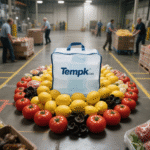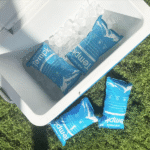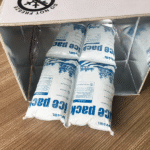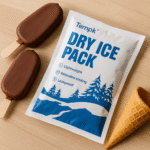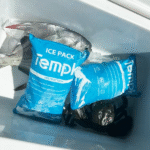Cold chain tracking and monitoring are essential for keeping perishable goods safe as they move through global supply chains. Real time data on location, temperature and humidity ensure that sensitive products such as vaccines, Biologika, Meeresfrüchte, dairy and fresh produce remain within their required temperature ranges. The global cold chain tracking and monitoring market was valued at USD 7.03 Milliarden in 2024 und wird voraussichtlich erreicht werden USD 16.67 Milliarden von 2033, reflecting a CAGR von 9.57% from 2025 2033. You need to understand how modern technologies—from IoT sensors and GPS devices to AI powered analytics—can help you maintain product integrity, Vorschriften einhalten und Abfall reduzieren.
Understand what cold chain tracking and monitoring entail, including the difference between basic monitoring and advanced end to end tracking systems.
Explore key technologies such as IoT sensors, GPS-Tracker, RFID tags and cloud platforms, and learn how they deliver actionable data.
Identify factors to consider when selecting a tracking solution, including hardware, Software, battery life, Konnektivität, scalability and security.
Overcome common challenges like network availability, kosten, data overload and regulatory complexity.
Discover industry specific applications, from food and beverage to pharmaceuticals, biologics and chemicals.
Stay current on 2025 innovations and trends, including blockchain traceability, solar powered cold storage, AI route optimisation and sustainability regulations.
Erhalten Sie Antworten auf häufig gestellte Fragen about compliance, data integrity and best practices.
What Is Cold Chain Tracking and Monitoring and Why Does It Matter?
Cold chain tracking and monitoring refer to the continuous collection and analysis of temperature, humidity and location data during storage and transport. Traditional monitoring solutions record temperature data locally for later retrieval, while advanced tracking systems combine environmental monitoring with real time location intelligence using GPS or cellular connectivity. By integrating sensors, data loggers and cloud software, these systems provide continuous visibility and send immediate alerts when conditions deviate from safe ranges, allowing you to intervene before spoilage occurs.
Warum ist es wichtig
Preserves product quality: Perishable items such as fruit, Gemüse, Molkerei, meat and seafood require strict temperature ranges (often 0–5 °C). Pharmaceuticals and biologics may require 2–8 °C or ultra low temperatures. Real time tracking prevents unnoticed deviations and ensures goods arrive safe for consumption or administration.
Supports regulatory compliance: Regulations like the EU’s Good Distribution Practice (BIP) and HACCP standards demand risk based temperature control, route planning and calibrated monitoring devices. In den USA, das Gesetz zur Sicherheit der Arzneimittelversorgungskette (DSCSA) mandates electronic traceability of prescription drugs to prevent counterfeit products.
Reduces waste and costs: The World Health Organization estimates that nearly 50 % of vaccines were lost in 2024 due to temperature excursions. Real time alerts allow quick corrective actions, minimizing product loss and saving money.
Builds trust and transparency: Customers and regulators expect clear evidence that products remained within safe conditions. Tracking systems provide secure logs and tamper proof records, improving accountability and consumer confidence.
Key Technologies Driving Cold Chain Tracking and Monitoring
Cold chain tracking depends on a combination of hardware and software. The following table summarises core technologies, their roles, und was sie für Sie bedeuten.
| Technologie | Rolle | What It Means for You |
| GPS-Tracker | Provide continuous location data and route information for shipments. | You always know where your shipment is and can reroute quickly in case of delays or theft. |
| IoT environmental sensors | Measure temperature, humidity and shock in real time. | Continuous data allows you to detect deviations immediately and take corrective actions to protect your goods. |
| RFID-Temperatursensoren | Enable contactless, automated data collection via RFID tags attached to pallets or packages. | Streamlines inventory management and reduces human error; Jedoch, signal range is limited and infrastructure costs can be higher. |
| Bluetooth niedrige Energie (Bloß) Sensoren | Provide short range, low power temperature monitoring. | Suitable for warehouses or local deliveries; they integrate easily with mobile devices but have limited range. |
| GPS based cold chain trackers | Combine location and temperature monitoring using GPS and cellular networks. | Enhance transparency and security; route optimisation reduces delays and ensures timely deliveries. |
| Cloud-Plattformen & Analytik | Centralise data, Bereitstellung von Dashboards, analytics and AI powered predictions. | Support predictive maintenance, automated alerts and regulatory reporting, reducing manual work and improving decision making. |
Praktische Tipps und Anregungen
Use multimodal sensors: Choose devices that measure temperature, Luftfeuchtigkeit, shock and location simultaneously. This reduces complexity and ensures comprehensive data.
Calibrate and validate devices regularly to meet regulatory requirements. GDP and HACCP standards require documented calibration and mapping of sensors.
Implement redundancy: Deploy backup power sources or multiple sensors in critical shipments to avoid data loss.
Leverage cloud dashboards: Use real time dashboards with geofencing to automate alerts when shipments deviate from approved routes.
Trainiere dein Team on interpreting alerts and taking corrective actions quickly; human response time is as important as technology.
Fall aus der realen Welt: A pharmaceutical distributor implemented IoT enabled GPS trackers on vaccine shipments. Während a 2024 shipment to a rural clinic, the system sent an alert when the trailer’s temperature rose above 8 °C due to a refrigeration malfunction. Staff rerouted the shipment to a nearby warehouse and transferred the vaccines to a functioning unit. Infolge, none of the vaccines were lost, demonstrating how real time monitoring prevents costly spoilage and protects patients.
How Do You Choose a Cold Chain Tracking and Monitoring Solution?
Selecting the right solution involves evaluating hardware capabilities, software features, Konnektivität, scalability and cost. Your aim is to balance reliability, ease of use and future proofing. Below is a guide to key considerations.
Hardware vs. Software: What to Prioritize?
Hardware provides the physical measurement and communication functions, while software aggregates and analyses the data. Hardware held approximately 78.1 % of the cold chain tracking and monitoring market share in 2024 because devices—sensors, Datenlogger, RFID tags and GPS trackers—are essential for collecting accurate data. Software and cloud platforms add intelligence through analytics and AI, enabling predictive alerts and route optimisation.
| Komponente | Schlüsselmerkmale | Überlegungen | Vorteile |
| Sensoren & Datenlogger | Measure temperature, humidity and shock; store or transmit data. | Evaluate battery life, calibration accuracy, memory capacity and IP rating. | Provide historical and real time environmental data necessary for compliance and quality assurance. |
| Connectivity Modules (LoRaWAN, GSM, Wi Fi) | Enable data transmission to cloud platforms. | Consider network coverage along your routes, roaming costs and latency. | Provide real time visibility across international shipments. |
| Cloud Software & Armaturenbrett | Aggregate data, generate alerts, analyse trends. | Choose platforms with user friendly interfaces, integration capabilities (APIs) and robust security. | Automate reporting, support predictive maintenance and improve decision making. |
| Ai & Analytics | Use algorithms to predict temperature excursions, optimise routes and detect anomalies. | Assess algorithm transparency, data governance and integration with existing systems. | Reduce response times, lower costs and improve sustainability. |
| Batterie & Power Management | Determines device lifespan and reliability. | Compare battery life (often months vs. Jahre), charging options and power saving features. | Long battery life reduces maintenance and ensures continuous data collection. |
Scalability and Interoperability
Start small and scale: Begin with critical routes or products and expand once reliability is proven. Look for solutions that integrate easily with additional sensors and future technologies.
Open standards: Choose systems that support standard protocols such as MQTT, HTTP and API integrations. This ensures that devices from different vendors can communicate and that data integrates with enterprise resource planning (ERP) or warehouse management systems.
Compatibility with existing infrastructure: Ensure your solution can integrate with existing data loggers, refrigeration units and fleet management software.
Security and Data Privacy
Encryption: Protect data at rest and in transit using strong encryption methods.
Role based access: Implement user permissions to control who can view and modify sensitive data.
Einhaltung der Vorschriften: Follow standards like GDPR (for EU data), HIPAA (for healthcare in the U.S.) and FSMA for food safety to avoid penalties.
Kostenüberlegungen
Gesamtbetriebskosten (TCO): Include device cost, subscription fees, connectivity charges and maintenance. IoT based sensors can be more expensive than basic data loggers but offer real time benefits.
Return on investment (ROI): Evaluate savings from reduced spoilage, improved efficiency and fewer regulatory fines.
Energieeffizienz: Solar powered units or devices with low power modes reduce operating costs, aligning with sustainability goals.
User Friendly Evaluation Checklist (Interaktives Element)
You can offer readers an interactive checklist, encouraging them to assess their specific needs. Here’s how you might structure it in a “HowTo” Schema:
Define the products you need to monitor (Impfungen, Fleisch, Meeresfrüchte, Chemikalien).
Identify the routes and environments (Kurzstrecke, Internationaler Versand, warehouse storage).
List regulatory requirements (BIP, Haccp, DSCSA, FSMA).
Determine data visibility needs (real time vs. post shipment reports).
Set a budget for hardware and software.
Evaluate vendor support and service agreements.
Plan for scalability and integration with existing systems.
Tatsächlicher Fall: A seafood exporter used a basic data logger that lacked real time alerts. When the shipment was delayed, the fish temperature rose above the safe range, resulting in spoilage. After upgrading to an IoT enabled, GPS linked sensor system with cloud alerts, the company avoided subsequent spoilage events and reduced insurance claims by 30 %, proving that investing in real time visibility saves money and reduces liability.
Overcoming Common Challenges in Cold Chain Tracking and Monitoring
Despite technological advances, implementing a robust tracking system can be challenging. Recognizing these obstacles and proactively addressing them will save you time and resources.
Herausforderung: High Costs and Complexity
Initial investment in devices, connectivity and software can be substantial. Market reports show that IoT based sensors offer advanced functionality but are more expensive and require stable network connectivity. To manage costs:
Implement tiered tracking: Use premium devices for high value or high risk products and lower cost options for less sensitive goods.
Consider subscription models that spread costs over time rather than large up front purchases.
Explore government or industry subsidies for adopting sustainable technologies such as solar powered cold storage.
Herausforderung: Connectivity Gaps and Data Reliability
Real time tracking relies on cellular or satellite networks, which may be unreliable in remote areas. Um dies abzumildern:
Use multi network devices that switch between GSM, Wi Fi, LoRaWAN or satellite networks.
Buffer data locally: Choose sensors with onboard memory that can store data during outages and transmit once connectivity resumes.
Plan routes that avoid signal “dead zones” or invest in low earth orbit satellite solutions for transoceanic shipments.
Herausforderung: Integration with Legacy Systems
Many logistics companies still rely on older warehouse management systems (WMS), making integration difficult. Open standard APIs and middleware solutions can bridge this gap. When evaluating providers, confirm that they support data export formats like JSON or CSV and integration with common ERP and WMS platforms.
Herausforderung: Regulatorische Komplexität
Cold chain regulations vary by product and region. Zum Beispiel, EU GDP guidelines require calibrated monitoring devices, secure record keeping and risk based route planning, während die UNS. DSCSA requires an interoperable electronic system to trace prescription drugs. Um die Einhaltung sicherzustellen:
Map your obligations: Identify applicable regulations (BIP, Haccp, DSCSA, FSMA, FDA’s Good Manufacturing Practice) and assign responsibilities.
Document processes: Maintain validated procedures for calibration, Datenprotokollierung, exception handling and corrective actions.
Auditieren Sie regelmäßig: Conduct internal and third party audits to verify adherence to standards and identify gaps.
Herausforderung: Data Overload and Analysis
Sensors generate massive amounts of data. Without proper analytics, you risk missing critical signals. To handle this:
Use analytics platforms that convert raw data into actionable insights. AI and machine learning tools can detect patterns, predict equipment failures and optimize routes.
Establish thresholds and alerts so that only significant deviations trigger notifications.
Personal schulen on interpreting dashboards and taking swift action.
Industry Specific Applications of Cold Chain Tracking and Monitoring
Essen und Getränk
Frische Produkte, Fleisch, dairy and seafood require strict temperature control. Real time monitoring reduces waste and ensures compliance with food safety regulations. Zum Beispiel, the European Food Hygiene Regulation EC 852/2004 mandates HACCP based procedures for food operators. Companies can benefit from temperature data loggers during storage and Bluetooth sensors for short range distribution.
Pharmazeutika und Biologika
Pharmaceuticals often require 2–8 °C storage, while biologics and cell therapies may require ultra cold conditions. Gute Vertriebspraxis (BIP) guidelines demand risk based temperature control, route planning and calibrated devices. Portable cryogenic freezers capable of maintaining –80 °C bis –150 °C are increasingly used for cell therapies. Real time GPS trackers integrated with IoT sensors and AI route optimisation protect these valuable shipments.
Chemicals and Specialty Materials
Industrial chemicals, specialty coatings and adhesives may require precise thermal conditions to preserve performance. Tracking systems with shock and vibration sensors can detect physical impacts, ensuring products are delivered intact.
Clinical Trials and Life Science Research
Clinical trial materials often travel internationally. Ensuring chain of custody integrity is crucial; blockchain enabled systems provide tamper proof records that regulators and sponsors can audit.
Foodservice and Grocery Delivery
E commerce platforms deliver groceries directly to consumers. Market data indicate that online grocery sales are projected to grow by USD 164 Milliarde, USD erreichen 646 Milliarden von 2029. GPS enabled trackers with mobile apps help ensure that deliveries remain within safe temperature ranges, building consumer trust.
2025 Innovations and Trends in Cold Chain Tracking and Monitoring
Trendübersicht
The cold chain industry is undergoing rapid transformation driven by technological advancements, sustainability goals and regulatory pressure. Innovations emerging in 2025 include blockchain traceability, solar powered storage, IoT enabled sensors, KI-Routenoptimierung, portable cryogenic freezers and stricter sustainability regulations.
Aktuelle Fortschritte auf einen Blick
Blockchain for end to end traceability: Blockchain creates a tamper proof ledger of product movement, ensuring secure, auditable records. Stakeholders can verify temperature, humidity and timestamps to prevent counterfeit drugs and maintain compliance.
Solar powered cold storage units: To address unreliable power grids in rural regions, solar refrigeration units provide sustainable and cost effective cooling. Commercial electricity costs averaged 13.10 cents per kWh in 2024, while solar costs range between 3.2 Und 15.5 Cent pro kWh, delivering significant savings.
IoT enabled smart sensors: Networks of connected sensors provide real time data and alerts via mobile apps. These devices measure temperature, Luftfeuchtigkeit und Standort, enabling predictive maintenance and rapid response.
KI-gestützte Routenoptimierung: Artificial intelligence analyses weather, traffic and historical data to devise optimal routes, reducing transit times and protecting sensitive products. AI also predicts temperature excursions and equipment failures, proaktives Eingreifen ermöglichen.
Tragbare kryogene Gefriergeräte: Designed for biologics and cell therapies requiring ultra low temperatures, these freezers maintain –80 °C bis –150 °C Während des Transports.
Stricter sustainability regulations: Der EU F gas Regulation 2024/573 phases down high GWP refrigerants and pushes cold stores toward CO₂ and hydrocarbons. Energy performance directives require zero emission buildings and energy audits. AFIR rules mandate public recharging infrastructure for electric trucks, and revised CO₂ standards for heavy duty vehicles require a 45 % reduction by 2030. These policies accelerate adoption of electric transport refrigeration units (eTRUs).
Markteinsichten
The cold chain tracking and monitoring market reflects these innovations and regulatory shifts. IMARC Group reports a market size of USD 7.03 Milliarden in 2024, projected to reach USD 16.67 Milliarden von 2033 bei einer CAGR von 9.57 %. Analysts at MarketsandMarkets estimate USD 5.3 Milliarden in 2022 wächst auf USD 10.2 Milliarden von 2026 (CAGR 16.6 %), while Grand View Research projects USD 35.03 Milliarden in 2024 mit einer CAGR von 23.0 % from 2025–2030. Discrepancies arise from different methodologies, but all underscore rapid growth driven by stricter regulations, IoT adoption and globalized supply chains.
Regulatory Outlook
Regulators emphasise continuous temperature control, documented monitoring and product integrity throughout the cold chain. Der European cold chain is governed by the ATP agreement for vehicle insulation, HACCP food hygiene law, Und Good Distribution Practice for pharmaceuticals. Sustainability rules include the F gas phase down Und zero emission building standards. In den USA, Die DSCSA requires electronic tracing of prescription drugs, and the Food Safety Modernization Act (FSMA) 204 rule mandates enhanced traceability of high risk foods. Companies should prepare for increased audits, energy reporting and sustainability disclosures.
Implikationen für Sie
Plan for sustainable refrigeration: Invest in low GWP refrigerants and solar ready facilities to comply with the F gas regulation and energy directives.
Electrify your fleet: Evaluate battery electric trucks and eTRUs to meet CO₂ reduction targets and access zero emission zones.
Adopt blockchain and AI tools: These technologies improve transparency, reduce fraud and optimise routes.
Bereiten Sie sich auf Audits vor: Document calibration, temperature mapping and exception handling to satisfy GDP, HACCP and DSCSA requirements.
Häufig gestellte Fragen
Frage 1: What’s the difference between monitoring and tracking in a cold chain?
Monitoring involves recording temperature and humidity data, often using data loggers that store information locally. Tracking combines environmental monitoring with real time location data, enabling immediate alerts and route adjustments.
Frage 2: Are IoT sensors worth the investment?
Ja. IoT enabled sensors provide real time visibility, automated alerts and predictive maintenance. While more expensive than basic loggers, they reduce product loss and improve operational efficiency.
Frage 3: How do I comply with GDP and HACCP?
GDP and HACCP require validated processes, calibrated devices, secure data logging and risk based route planning. Maintain documented procedures and perform regular audits.
Frage 4: What is DSCSA and how does it affect my operations?
Der Gesetz zur Sicherheit der Arzneimittellieferkette (DSCSA) calls for an interoperable electronic system that can identify and trace prescription drugs at the package level. You must ensure that your systems can capture and exchange product identifiers and transaction information.
Frage 5: Can cold chain tracking improve sustainability?
Ja. Real time tracking optimises routes, reduces energy consumption and supports electric vehicles and solar refrigeration. Regulations like the F gas phase down and zero emission building standards push the industry toward sustainable practices.
Zusammenfassung und Empfehlungen
Key Takeaways
Cold chain tracking and monitoring combine temperature/humidity sensing with real time location data, providing end to end visibility and enabling proactive intervention.
Technologies such as IoT sensors, GPS-Tracker, RFID tags and AI analytics form the backbone of modern systems, helping reduce waste and comply with regulations.
Market growth is rapid, with valuations ranging from USD 7.03 Milliarden in 2024 to projections of USD 16.67 Milliarden von 2033 Und CAGR up to 23 %.
Regulatory frameworks like GDP, Haccp, DSCSA and sustainability mandates demand documented monitoring, calibrated devices and low emission practices.
2025 Innovationen—blockchain traceability, solar powered units, KI-Routenoptimierung, portable cryogenic freezers and electrified fleets—are reshaping the industry.
Umsetzbare nächste Schritte
Überprüfen Sie Ihre aktuelle Kühlkette: Map all products, routes and temperature requirements. Identify gaps in monitoring or traceability.
Select technology based on product value and risk: Use real time IoT sensors for high value items and lower cost loggers for less sensitive goods.
Invest in sustainable infrastructure: Upgrade to low GWP refrigerants, solar ready facilities and electric transport refrigeration units.
Implement blockchain or secure digital records: Ensure tamper proof documentation of product movement and temperature history.
Train your team and assign responsibilities: Ensure everyone knows how to respond to alerts and maintain compliance documentation.
Partner with reputable vendors: Look for providers offering robust hardware, open standard software and dedicated support.
Monitor regulatory updates for GDP, Haccp, DSCSA and sustainability rules; adapt processes accordingly.
Über Tempk
Tempk is a trusted provider of cold chain solutions, specialising in Isolierte Verpackung, gel ice packs and IoT enabled tracking systems. Our team combines decades of experience in thermal engineering and logistics mit cutting edge research and development. We design products that maintain precise temperature ranges, reduce environmental impact and comply with global regulations. Unser solutions span food, pharmazeutisch, biotech and chemical industries, ensuring that goods arrive safe, potent and ready for use.
Aufruf zum Handeln
Ready to elevate your cold chain? Kontakt tempk to discuss your unique challenges and explore tailored solutions. Whether you need real time tracking devices, eco friendly packaging or compliance guidance, our experts are here to help you protect your products and your reputation.



















